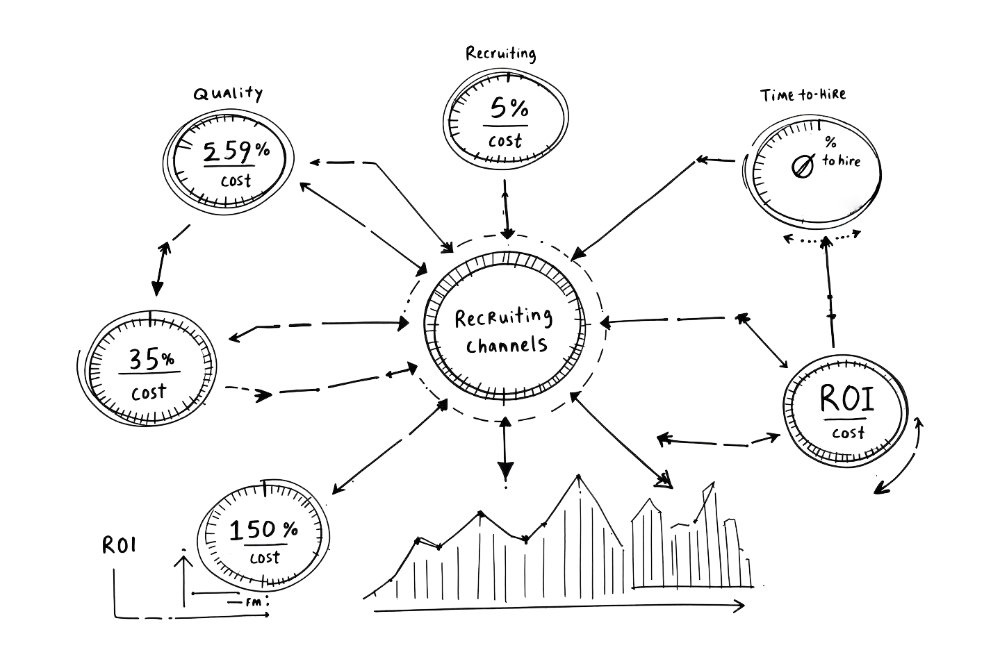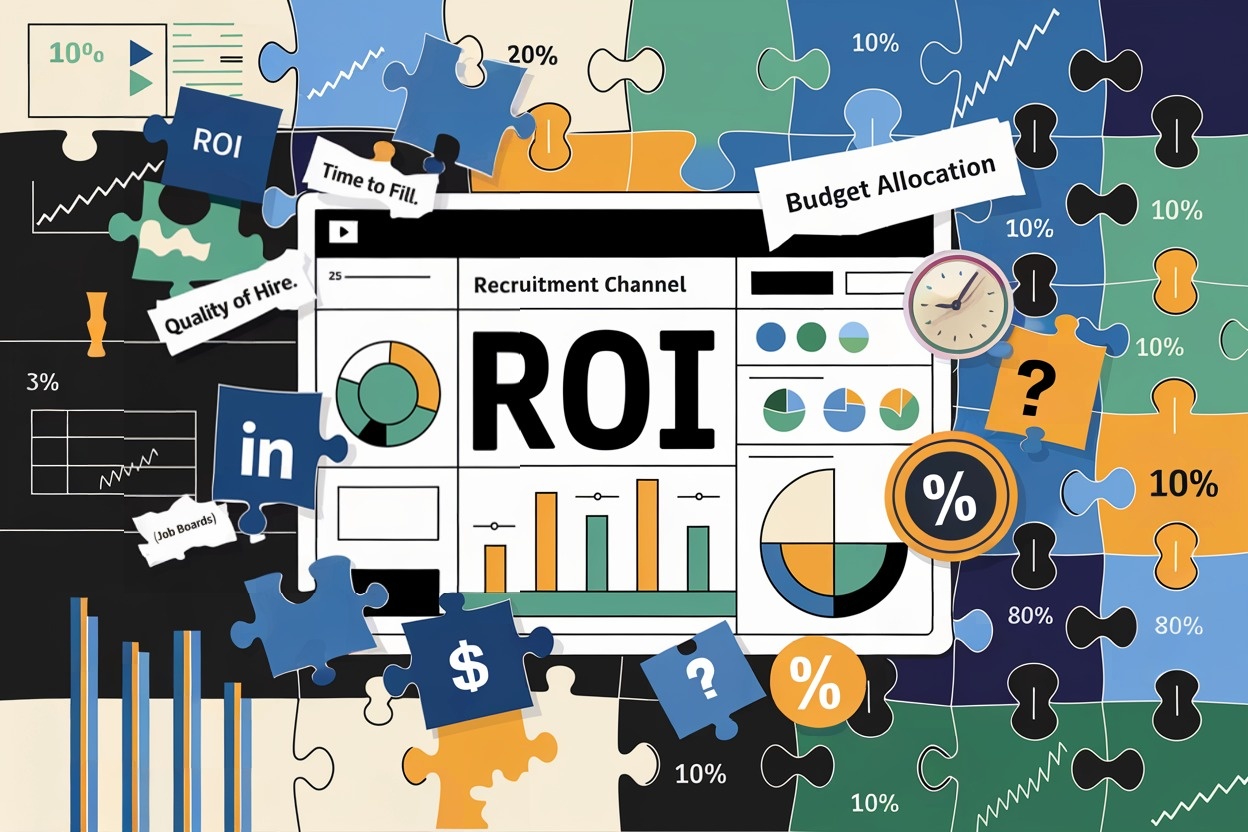There’s a certain feeling of overwhelm that creeps in when you sit down to evaluate ROI for multiple recruiting channels. It can feel like trying to assemble a 2,000-piece jigsaw puzzle in dim lighting: you see fragments of a bigger picture, but the entire image remains stubbornly elusive. Throw in channels like LinkedIn, Indeed, that one specialized job board you tried last quarter, and maybe a trickle of candidates from social media—it’s a lot to keep straight. And even if you manage to track candidate volume, how do you effectively measure quality of hire and time to fill so you know where your budget really belongs?
In this article, we’ll walk through practical steps and insights for measuring ROI on each recruiting channel, with a focus on LinkedIn (since that platform is frequently top-of-mind). We’ll give you a workable plan without dramatizing every minor detail. By the end, you’ll be able to apply these methods to see whether a channel is truly earning its keep or just draining your recruitment budget.
Why Measuring ROI Matters in Recruitment
Many companies just guess where to spend their recruiting money. While gut feelings can help, they’re not always reliable - especially since each recruiting channel costs differently and may or may not work well. When you track how well your money is working, you can make smarter choices based on real results. This helps you:
- Focusing on High-Return Channels: If Indeed is providing twice as many long-staying employees as your social media campaigns, you can pour more budget into Indeed with confidence.
- Dropping Underperformers: If a niche job board costs a fortune but consistently yields high-turnover hires, it might be a sign that you’re burning money on that channel.
- Justifying Budget to Leadership: It’s a lot easier to explain “We spent $5,000 on LinkedIn because we see an annual cost-per-hire savings of 20% over other channels” than “We just feel like LinkedIn is cooler.”

From a high-level perspective, ROI is typically calculated as:
But recruitment channels each complicate the formula. LinkedIn might have a pay-per-click or pay-per-impression structure, while an internal referral program has no explicit costs but a hidden overhead of staff time or referral bonuses. Without a careful breakdown, it’s easy to conflate channel performance or ignore intangible costs.
Pinpointing the Right Metrics
It’s difficult to talk about ROI without first clarifying what exactly goes into your equation. Here are some of the core metrics:
Cost per Hire (CPH): This is the big one—you add up all the costs associated with your hiring efforts (advertising fees, recruiter salaries, etc.) and divide by the number of hires from that channel. If LinkedIn costs $4,000 in ads and subscription fees per month, and you make four hires from it, your cost per hire is $1,000.
Time to Fill: How long does it take to fill an open role using each channel? If LinkedIn consistently delivers the right candidates in 20 days, while a conventional job board drags out to 40 days, that’s a significant difference for productivity.
Quality of Hire: This can be trickier to measure. Some companies use performance reviews, manager satisfaction surveys, or retention rates within the first year to gauge whether the channel is providing individuals who are truly successful in the role.
Retention and Attrition Rates: If you notice that 70% of hires from LinkedIn are still with you a year later, compared to 40% from another board, that influences the real ROI. The cost of replacing an employee is no joke, often 1.5–2 times the annual salary.
Conversion Rates: This refers to the funnel stages. For instance, if your channel yields 500 applicants but only 2 hires, you’ll want to see where the funnel is dropping off. It could be that the channel simply isn’t targeting the right audience or you’re not presenting an appealing opportunity to those candidates.
The important note is that these metrics are complementary. You don’t want to fixate on just one—like cost per hire—because it could mislead you if the new hires keep quitting. At the same time, ignoring cost while chasing “perfect fit” can be economically unsustainable.
Setting Up Data Collection and Tracking
The Role of an Applicant Tracking System (ATS)
An ATS is your best friend for ROI measurement, primarily because it logs where candidates are coming from as soon as they enter the pipeline. If you’re doing it manually, or if you’re switching from one spreadsheet to the next, you’ll spend half your time just figuring out who applied from LinkedIn and who came from Indeed. A good ATS helps you:
- Tag incoming applicants by source automatically.
- Track which stage each candidate reaches in the hiring funnel.
- Measure how many hires come out of each channel in a specific timeframe.
When your data is all in one place, you can quickly see that, say, LinkedIn brought in 300 candidates, 20 were interviewed, and 5 were hired, whereas another channel brought in 200, 10 interviewed, 3 hired, and so on. That sets the groundwork for deeper analysis: “Which channel had more interviews to offer ratio?” “Which channel had a higher cost per hire?” etc.
Modern ATS platforms like Machine Hiring help streamline your recruitment process and data management. With a modern ATS, you can:
- Keep all candidate data organized in one place
- Track applications and hiring stages
- Customize your hiring workflow
- Access candidate documents securely
- Make data-driven hiring decisions
This structured approach helps lay the foundation for measuring channel ROI effectively.
Want to see how Machine Hiring can help streamline your recruitment process? Request a demo today.
Guarding Against Multi-Channel Mix-Ups
It’s common for a candidate to see your company’s social post, click an ad on Google, and then finally apply through Indeed. This multi-channel complexity makes it tough to assign a single “source”. Some companies adopt a multi-touch attribution model: for instance, 40% credit to the first channel, 40% to the last channel, 20% to everything in between. While that might seem complicated, it can give a more nuanced view of your full funnel.
If that feels overwhelming, you can at least track the final channel where the candidate applied, with an option in your ATS or application form that asks, “How did you hear about this job?” It’s not perfect, but it’s a starting point.

Breaking Down Costs Accurately
It’s one thing to say, “We spent $3,000 on LinkedIn.” But that might not capture the full story. Let’s look at the hidden elements:
- Advertising Costs: These might be pay-per-click or pay-per-impression on LinkedIn, or a flat fee on job boards.
- Recruiter Overhead: Salaries or hourly wages for recruiters who spend a disproportionate amount of time sourcing on LinkedIn vs. other channels.
- Software or Subscriptions: LinkedIn Recruiter seats can be pricey, and specialized job board subscriptions can also add up.
- Time: Hours spent screening applicants might be higher if a channel sends you a flood of mediocre candidates. That’s also a cost, even if it doesn’t show up as a direct invoice.
To measure ROI properly, total up each of these line items for each channel and note them in one central location. That might sound tedious, but it yields a truer picture of your real spend. Once you have an accurate cost total, you can divide it by hires, by quality of hire, or by some long-term value metric if you want an even deeper level of analysis (e.g., average performance rating after six months, or the employee’s contributions to key projects).
Calculating Long-Term Value
Sure, time to fill and cost per hire are immediate metrics, but long-term success is where many recruiters find the real story. If hires from LinkedIn have a lower turnover rate and higher performance over 12–24 months, their cost per hire might be higher upfront, but the overall ROI is stronger. Consider:
- Performance Evaluations: You could average each new hire’s first-year performance score. If you see a consistent difference between channels, that’s a sign.
- Promotion Speed: In some roles, a faster path to promotion can mean the channel is bringing in candidates well-aligned to your growth culture.
- Salary Impact vs. Productivity: In revenue-generating roles like sales, a new hire’s ability to meet or exceed targets can be a tangible metric. If a particular channel delivers top-performing sales reps who close more deals, that’s a measurable financial impact that offsets a higher initial recruiting cost.
The idea is: you’re not merely chasing cheap, quick hires; you want hires that boost your organization over the long term.
Common Pitfalls and How to Avoid Them
1. Overlooking Quality Metrics
It’s tempting to chase the lowest cost per hire, ignoring the fact that some hires fail to meet performance expectations. This can create a revolving door of replacements, which is far more expensive in the grand scheme.
2. Inconsistent Data Tracking
If you don’t have a standardized process—like “Everyone must log final source in the ATS and track it consistently”—your data will be full of holes. Then your ROI calculations become guesswork.
3. Neglecting Retention
Retention is a big factor in measuring real ROI. If you only measure up to the offer acceptance date, you miss out on who’s leaving within 90 days and who’s thriving at 12 months.
4. Failing to Revisit Metrics
ROI is dynamic. A channel might perform well in Q1 but taper off by Q3 if market conditions change or the talent pool shifts. Keep revisiting your channel performance to adapt as needed.
A Look at LinkedIn Specifically
Since LinkedIn is such a prominent channel, let’s briefly address its nuances:
- Cost Structure: You might have subscription costs for LinkedIn Recruiter. Plus, there are fees for posting and advertising jobs. Sometimes you pay for impressions or clicks, so your spend might fluctuate month to month.
- Candidate Quality: LinkedIn tends to attract more mid- to senior-level professionals, which can mean fewer applicants but potentially stronger alignment with specialized roles.
- Speed of Sourcing: In certain industries, LinkedIn can fill positions faster because you can proactively reach out to candidates. This speed may reduce your time to fill.
- Branded Outreach: Your employer brand can shine through personal InMail, company updates, and group engagement. This intangible boost can pay off if you continuously engage potential applicants, but it’s tough to quantify. Still, it can indirectly improve ROI over time.
The key is to compare how LinkedIn’s performance stacks up against other channels: how many offers accepted, how many become high performers, how many stay past a year. If all the data points are positive, that justifies the higher costs. If the data tells you otherwise, it might be time to recalibrate.

Real-World Example: From Data to Decisions
Let’s imagine a mid-sized SaaS company realized they were spending $10,000 per month on LinkedIn ads. Over three months, they brought in 30 hires, so it looked like a cost per hire of around $1,000. Sounds reasonable. But they also noticed that 10 of those hires left within six months, leaving them with a net of 20 longer-term employees at an actual cost of $1,500 each. By measuring that turnover metric (and the replacement costs), they saw that LinkedIn’s real cost per successful hire was higher than they first assumed.
At the same time, they discovered a specialized professional association job board was producing fewer hires but at a lower turnover rate—meaning a steady pipeline of quality candidates. Ultimately, the company decided to maintain its LinkedIn budget but shift 20% of that spending into the professional association channel. After a year, they revisited the numbers and saw improved retention overall. That’s data-driven ROI in action.
Practical Steps to Get You Started
- Pick Your Key Metrics: Decide on a balanced set of data points—cost per hire, time to fill, quality of hire, and turnover rate at 90 or 180 days.
- Standardize Your Data Input: Use an ATS or consistent spreadsheet entries so that every candidate is tagged with their source.
- Calculate Comprehensive Costs: Remember not to miss recruiter overhead, software fees, or intangible time investments.
- Build in Regular Reviews: Maybe once a quarter, compare performance across all channels. Which channels improved? Which worsened? What changed?
- Refine and Reallocate: If the data shows a clear winner, allocate more budget there. If a channel is floundering but still necessary (for diversity or niche roles), make adjustments carefully.
- Don’t Fear Testing: Pilot a new channel for a few months. Track data meticulously. If it shows promise, expand. If it’s a dud, cut losses early.
Final Thoughts
Measuring ROI for each recruiting channel can feel like a chore, but once you have the right systems in place, it becomes second nature. The real payoff is clarity: knowing which platforms bring you top talent that stays, which ones bring you quick hires but questionable longevity, and how each channel influences your overall hiring strategy.
Now is the time to implement a robust ROI framework. Start with simple metrics, upgrade as your data matures, and always keep refining your approach. None of these metrics are set in stone, and each organization might weigh them differently. But if you track costs thoroughly, monitor time and quality, and adjust in response to the data, you’ll be on your way to building a more efficient, effective, and future-proof talent pipeline.
Ready to bring more structure to your recruiting data? Request a demo today and discover a simpler, clearer route to understanding exactly where your recruiting resources pay off.
Related Posts
- The Cryptic Secrets of Data-Driven HR: Metrics that Actually Matter (and Some That Might Make You Laugh)
- Recruitment Metrics That Matter in 2025: Moving Beyond Time-to-Hire
- Unlocking the Competitive Edge: Benchmarking Your Talent Acquisition Metrics
- Talent Acquisition Automation: Revolutionizing Recruitment
- What Is Predictive Analytics in Recruitment and How Can It Help?


